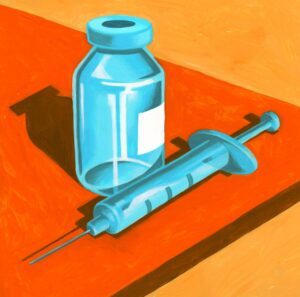Historically Speaking: Diabetes and the Miracle of Insulin
One hundred years ago, a team of Canadian researchers showed that an age-old disease didn’t have to mean a death sentence.
July 22, 2021
The human body runs on glucose, a type of sugar that travels through the bloodstream to the cells where it converts into energy. Some 34.2 million Americans are diabetic; their bodies are unable to produce the hormone insulin, which regulates how glucose is processed and stored in the cells. Without treatment the condition is terminal. The discovery of insulin a century ago this year was one of the great medical breakthroughs of the 20th century.
Diabetes was first recognized some 4,000 years ago. The Ebers Papryus, an Egyptian medical text written around 1550 B.C., refers to patients suffering from thirst, frequent urination and weight loss. An ancient Indian text, the Sushruta Samhita, composed after the 7th century B.C., advised testing for diabetes by seeing whether ants were attracted to the sugar in the urine.
The disproportionate amount of urine experienced by sufferers is probably the reason why the ancient Greeks called it “diabetes,” the word for “siphon” or “to pass through.” They also made the link to lifestyle: The 5th century B.C. physician Hippocrates, the “father of medicine,” advocated exercise as part of the treatment.
Early on, the Chinese recognized that an unbalanced diet of sweet, rich and fatty foods could play a role. Lady Dai, a minor aristocrat who died in the 2nd century B.C., was a textbook case. Her perfectly preserved mummy, discovered in southern China in 1971, revealed a life of dietary excess. She also suffered the consequences: osteoarthritis, high cholesterol, hypertension, liver disease, gall stones and, crucially, diabetes.
Over time, physicians became more expert at diagnosis. The role of sugar came into sharper focus in the 1770s after the English doctor Matthew Dobson discovered that it stayed in the blood as well as urine. But no further progress was made until the end of the 19th century. In 1889 Oskar Minkowski conducted experiments on dogs at the University of Strasbourg to prove that a nonfunctioning pancreas triggered diabetes.

ILLUSTRATION: THOMAS FUCHS
By the early 20th century, scientists knew that a pancreatic secretion was responsible for controlling glucose in the body, but they couldn’t isolate it. The Canadian researchers credited with finding the answer— John Macleod, Frederick Banting, Charles Best and James Collip —were an unlikely team. Banting was a surgeon not a scientist. Yet he sufficiently impressed Macleod, a professor of physiology at the University of Toronto, that the latter lent him lab space and a research assistant, Best. The pairing almost ended in a fist fight, but Banting and Best got over their differences and in July 1921 successfully injected insulin into a dog.
Macleod then brought in Collip, a biochemist on a research sabbatical, to help make a human-compatible version. This led to more infighting and Collip threatened to leave. The dysfunctional group somehow held together long enough to try their insulin on a 14-year-old named Leonard Thompson. He lived another 13 years.
The research team sold their patent rights to the University of Toronto for $1, believing insulin was too vital to be exploited. Their idealism was betrayed: Today, manufacture of the drug is controlled by three companies, and according to a 2018 Yale study published in JAMA, its high cost is forcing 1 in 4 Americans to skimp on their medication. The next frontier for insulin is finding a way to make it affordable for all.
